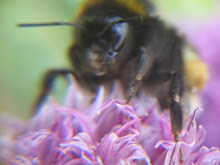



One plant that was really full of bees, bugs and butterflies last week was the rose that lines the outlet from the lake. Although almost completely inaccessible, i managed to climb down the bank over the wall and see that there were lots of insects feeding on the flowers.
I found it difficult to catch anything though and got nettled up my arms and legs, plus i left my scissors in the bushes (after collecting a sample to press), but the smell was heavy and sweet and i sat for a while listening to the water running and the bees buzzing.
The roses fell apart when i tried to press them - so i don't think it'll be such a good pressing, but we'll see.

No comments:
Post a Comment